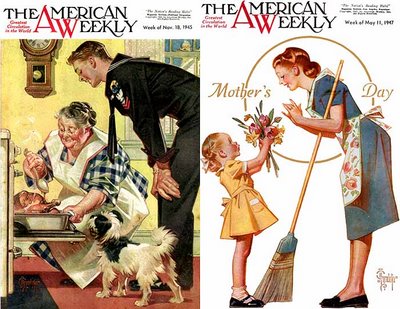Influences - J.C. Leyendecker


Joseph Christian Leyendecker, J.C. to his friends. J.C. Leyendecker was THE most successful, accomplished, famous artist of his day. He was beyond famous actually. When Norman Rockwell was a boy, he used to go to the train station in New Rochelle just to watch J.C. arrive from New York City, get off the train with his entourage and step into a waiting chauffeured limousin. Leyendecker was a celebrity on the level of the Beatles before they existed and his work defined American life by capturing the essence, the innocence which existed in the country in the years between 1900 and World War II. His work appeared as illustrations for The Saturday Evening Post, Collier’s Magazine, The American Weekly, Success Magazine and others, as well as magazine ads for companies such as Kelloggs, Kuppenheimer’s Clothiers and Arrow Collars (the character he created for Arrow Collars was based on one of the male models he frequently used. The Arrow Collar man became so famous and popular with the ladies that the company actually received fan mail wanting to know who he was, what was his name, where did he live . . . and he was even more famous than Rudolph Valentino) The covers of these magazines provided the perfect medium for reproducing his work in all its splendor. At the peak of his career he was the most famous Post artist they had ever had. He turned the Post covers into mini-posters, incorporating all of the elements of the cover into each piece.
Artistically speaking, Leyendecker was an incredible genius whose work is instantly recognizeable even today. He was the king of America’s “Golden Age” of illustration and through his work he virtually invented the look of the modern magazine cover as a purely attention grabbing device. Leyendecker’s work contains elements of both Art Nouveau and Art Deco, and it is dynamic, graceful, elegant and sophisticated. His unique style of painting captured the attention of the public as nothing before had, and only a handful since have.
J.C.’s work was about the endless pursuit of perfection. He developed his own system of creating an image based on the working methods of the great masters. He began with a series of thumbnail sketches, and from there he would work up a series of larger rough paintings. These were used to determine how to best proceed with the actual finished painting. When he applied his colors, he would let areas of blank, raw canvas show through. These were often areas which would be included as part of a highlight or the white background. J.C. was very secretive about how he worked and very little was known about how he achieved such luminous finished surfaces until his brother, Frank, shared the paint recipe with Norman Rockwell after swearing him to absolute secrecy. The colors were composed of Turpentine, stand oil and linseed oil, mixed fresh each morning in specific proportion. The colors were very thin, “slippery” if you will. When these colors were applied to the canvas they showed no sign whatsoever of having been applied by a brush. This resulted in a finished painting composed of precisely arranged areas of light and color. Every stroke was applied perfectly . . .once. J.C.’s brush control and mastery of his talents are legendary still today.
Leyendecker’s finished canvases were masterpieces of technique, color and magic. He influenced America at a time when we were just beginning to discover who we were as a nation. His work has influenced me to my very core and I am extremely grateful. I enjoy looking at his work over and over.
J.C. Leyendecker lived a quiet personal life that included a circle of very few friends. I wish I had been there. For all of his fame a fortune, for all of the love and admiration he received from his adoring public, he died alone in his home by the sea, in New Rochelle, New York. I feel him with me every day.
- The Light Within . . .








<< Home